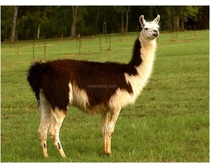Llamas are regarded as important companion animals. With this article, check out interesting facts and amazing information on Llamas.
Facts About Llama
Llamas belong to the Camelid family, having long necks, limbs and rounded muzzles. They are regarded as indispensible pack animals and herds of them are maintained by the natives in Argentina, Bolivia, Peru and Ecuador. In fact, llamas are used to carry about 25 to 30% of their body weight for several miles. They are also very important commercially, as their fine inner coat is used for crafting garments and handicrafts, mainly in North America, Australia and Europe. The fibers obtained from a llama are very soft and free of lanolin naturally. Known for their highly proficient digestive system, llamas have a three-compartment ruminant stomach and are known to chew their cud like sheep and cattle. The two basic adaptations in their bodies, which help them reside in low oxygen, high altitude environments, are the unusually high hemoglobin content in their blood stream and oval red blood corpuscles. To know more about this unique animal species, have a glance at the interesting facts and amazing informationthat we have provided for you below.

Facts About Llama
Binomial Name: Lama glama
Kingdom: Animalia
Phylum: Chordata
Subphylum: Vertebrata
Class: Mammalia
Order: Artiodactyla
Family: Camelidae
Genus: Lama
Species: L.glama
Height: 1.7 m to 1.8 m (5.5 to 6 ft)
Weight: Approximately 130 to 200 kilograms (280 to 450 lb)
Life Span: 15 to 29 years
Diet: Herbivorous, grass is their staple diet
Range: Andes mountain range of South America in Peru, Chile, Bolivia and Ecuador
Habitat: Grasslands, mountainous areas and deserts
Age of Sexual Maturity: Males: 3 years, Females: 12 months
Gestation Period: Approximately 350 days (eleven and half months)
Number of Offspring: One
Interesting & Amazing Information On Llamas
- Llamas can be classically subdivided into two types: the short coated Ccara and the medium coated Curaca.
- There are around 35 different shades of llama wool, ranging from white and black to different shades of brown and grey.
- Llamas are devoid of hooves and each of their foot comprises of two toes, with soft pads.
- Llamas were native to the Central Plains of North America, but gradually migrated to South America, some three million years ago.
- Around 4000 to 5000 years ago, these animals were domesticated and used as pack animals by Indians, in the Peruvian highlands.
- Llamas are herbivorous, with very efficient digestive systems.
- At present, the population of llamas in the United States and Canada is around 20,000 to 25,000, while that of llamas and alpacas together in South America is around 7 million.
- Llamas are very social animals and always live together with other llamas or herd animals.
- They make excellent packers, as they are very agile and sure-footed and can carry weight up to 80 lbs or 25% of their body weight. Besides, the leathery pad over their two-toed foot helps them maintain a low environmental impact, very similar to a hiker’s athletic shoe.
- Llamas mainly communicate with each other is by making a kind of humming sound or by bodily postures (particularly their ear, body and tail postures). However, during the breeding season, they make a distinct orgling sound.
- To ward off any unwanted suitors and to establish the pecking order within the group, llamas are known to spit on each other. Occasionally, they are also known to spit on humans, if they have been mishandled, threatened or abused.


See also
More from iloveindia.com
- Home Remedies | Ayurveda | Vastu | Yoga | Feng Shui | Tattoos | Fitness | Garden | Nutrition | Parenting | Bikes | Cars | Baby Care | Indian Weddings | Festivals | Party ideas | Horoscope 2015 | Pets | Finance | Figures of Speech | Hotels in India : Delhi | Hyderabad | Chennai | Mumbai | Kolkata | Bangalore | Ahmedabad | Jaipur
- Contact Us Careers Disclaimer Privacy Policy Advertise With Us Lifestyle Sitemap Copyright iloveindia.com. All Rights Reserved.




